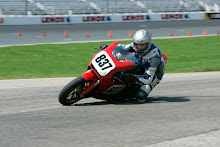Guess I'm getting ahead of myself a little. . .
Last Monday and Tuesday were the first Fishtail Riding School track days of the season. I've been riding with these folks for seven years now, and Mary and I have been holding things down (sometimes literally) in Turn 11 for at least five years as cornerworkers. Everybody on the Fishtail crew loves to ride, the instructors are excellent, the food is great, and NHMS is an amazing track. There were hugs all around on Monday morning, old friends greeting each other after a winter away, new bikes to admire, new paint on old bikes, etc. My baby was finally ready, my having finally learned how to synch carbs last weekend- that's an amazing feeling, watching the liquid columns, turning the adjusters, and listening to the bike hit that rhythm. The fairing lower was all glassed up, new oil dams front and rear, and all recontoured where the exhaust had burned through and I had ground it down in Turn 2. I had finished it off by painting the lower bright green. . . have rattlecan, will tricolore.
The morning went well, even with Bruce and Susie still in California. The cornerworkers duly waited until the third session to go out. . . and oh, my, was my little TT2 happy to be out there. The new forks are great. . . the old WP USD's are great forks, but I had never bothered to put the time into setting them up, because I knew they were going. The Showas, sprung and valved. . . well, let's just say I no longer have to be ready to have the wind knocked out of me at the Turn 3 pavement transition. Sooo easy to ride. . . and with those Dellorto squirtguns, she's like a whole new bike. But- last year, I had a pretty good idea how fast I was going, because going fast was a real wrestling match. This year, smooth and nice. . . so, of course, I did the classic, stupid, first session after lunch, first lap, feeling good, through 3, over the hill, down into the Bowl, set up for Turn 6, lay it over for the apex cone, what am I doing on the ground? Well, if you're gonna crash, might as well do it in front of the photographer! John Owens (Owens Racing Photos) has gotten some great shots of me over the years, and thankfully held the button down when he saw me hit. I don't have the disk yet, but as soon as I do, I'll post some here. Robby Nigl was the first rider to me, and I'm sooo happy he stood the bike up, twisted the clutch master around the right way, looked it over, and told me to ride her back to the pits.
Mary had a great day on her RD400, bump/roller starting and all with the new electronic ignition (and looking great in it's new Steve D'Angelo paint job). Tuesday, we both brought our "modern" Ducati's, Mary riding Fugly, her '95 900SS, and I on my "little girl", the '99 SS750ie I raised from the dead a few years ago.
Well, enough time at the keyboard! Saturday awaits!












